Samsung Galaxy S 4 Review - Part 1
by Brian Klug on April 24, 2013 12:01 AM ESTBattery Life and Charge Time
The Galaxy S 4 features a removable 9.88Wh battery with 3.8V chemistry. The battery design is par for the course for any high end smartphone, but the fact that it's removable remains a staple of the Galaxy S design. Whether or not the bulk of consumers actually use the flexiblity offered by a removable battery is up for debate, but there's no doubt about the fact that Samsung has a strong following of users who appreciate the feature.
Unfortunately, only having access to the Sprint version of the Galaxy S 4 to review, most of our battery life tests on the cellular network aren't all that useful. The good news is that our WiFi tests should at least give you an idea of how well the SGS4 will compare to the HTC One when both are on the same network. We're using the latest revision of our smartphone battery life test to compare performance of all the key players here. This is now our sixth revision of the battery life test, and we feel is the optimal balance between challenging workloads and idle time. The basic overview is the same as the previous test — we load webpages at a fixed interval until the handset dies, with display set at exactly 200 nits as always. Power saving features are disabled if they turn on automatically, and background account sync is disabled. The test is performed over both cellular data on all available air interfaces and over WiFi in an environment with good signal levels. The new test has decreased pause time between web page loads and added a number of JavaScript-heavy pages. I sat down with some UMTS RRC (Radio Resource Control) emulator tools and also made sure we had a good balance of all the RRC states (DCH, PCH if possible, FACH, IDLE) so we weren’t heavily biased towards one mode or the other.
As the most relevant comparison of platforms we have today, we'll start with the WiFi version of our web browsing test:
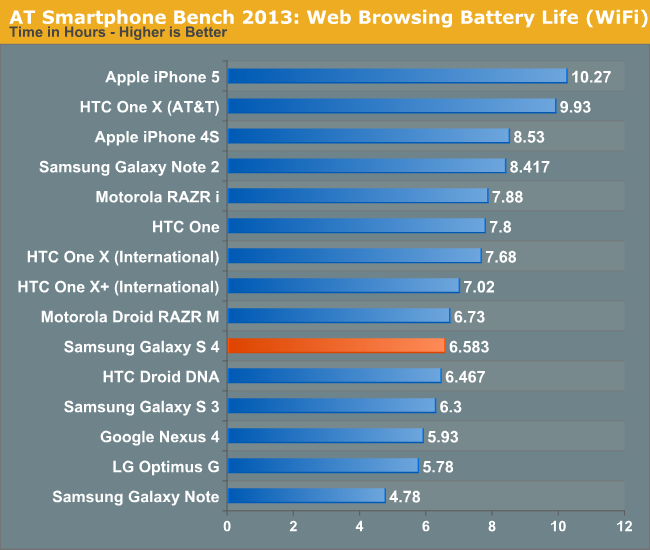
On WiFi the Galaxy S 4 falls behind the HTC One by an appreciable amount, however there's still an improvement in battery life compared to the Galaxy S 3. The Galaxy S 4's battery life isn't bad by any means, but do keep in mind that this is a large phone with a large display and a very powerful SoC. For much of the past year we've been talking about an increase in dynamic range in total platform power of high end smartphones and the Galaxy S 4 is no exception. Run it at full brightness or keep many cores running in their maximum performance states for a considerable period of time and you'll be greeted by a phone that's quickly in need of a power outlet.
As I mentioned earlier, we only have access to the Sprint version of the Galaxy S 4 at this point which unfortunately means that our 3G results aren't all that comparable to other devices here.

Even on Sprint, the Galaxy S 4 does surprisingly well.
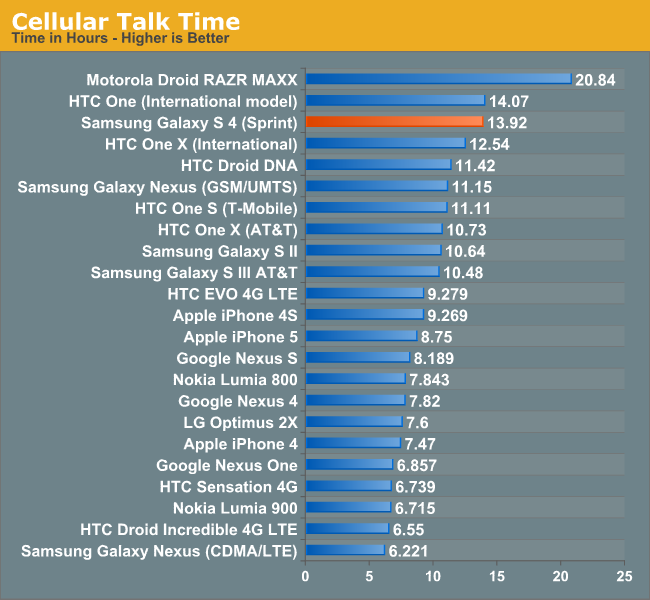
Talk time is excellent on the Galaxy S 4, with the phone delivering effectively the same battery life as the HTC One. Without having to power on that huge display, the Galaxy S 4 can last for a very long time on a single charge.
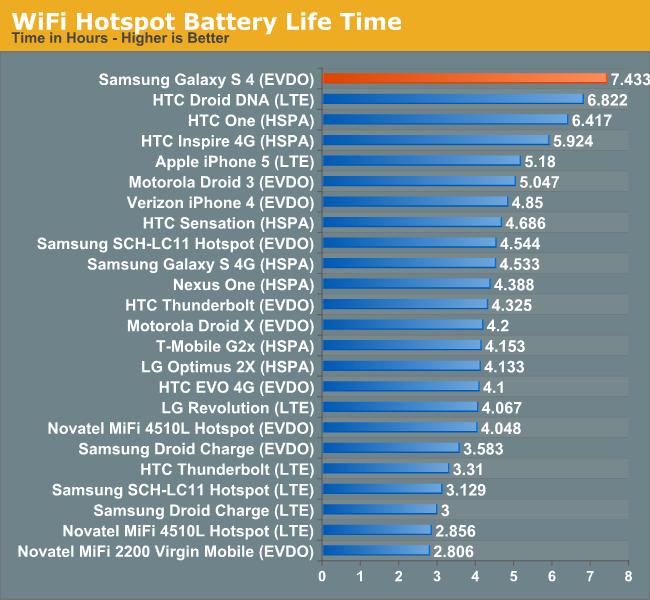
A combination of the Sprint network and the fact that the Galaxy S 4's display remains off during our hotspot test resulted in great battery life here as well. Again, this data isn't all that useful if you're not on Sprint but Samsung tells us we should be able to get our hands on an AT&T SGS4 in the not too distant future.
Charge Time
Samsung appears to implement Qualcomm's Quick Charge specification in the Galaxy S 4 and its bundled charger. I realize we haven't done a deep dive into what Quick Charge is and how it works, but I'll try to go through a quick explanation here. Most conventional chargers are linear, they take a fixed amount of input current (at 5V) and pass it along to the device being charged. The problem is that at deeply discharged states, the device's battery might be at a substantially lower voltage. A traditional linear charger won't change the current supplied based on the voltage of the battery being charged, and as a result can deliver sub-optimal charge times. When implemented, Qualcomm's Quick Charge technology can vary output current based on the voltage of the battery being charged, which results in less power being dissipated as heat and more being delivered to charging the battery itself. The table below helps illustrate the savings:
Quick Charge, at least in its currently available 1.0 specification, is still bound by the 5V limits of the USB BC 1.2 specification. The next revision of Quick Charge will enable higher voltage operation for even faster charge times.
| Qualcomm Quick Charge 1.0, Theoretical Example | ||||||
| Input Current @ Voltage | Input Power | Output Current @ Discharged Battery Voltage | Output Power | |||
| USB BC 1.2 - Linear Charger | 475mA @ 5V | 2.375W | 475mA @ 3V | 1.425W | ||
| Qualcomm Quick Charge 1.0 | 475mA @ 5V | 2.375W | 700mA @ 3V | 2.100W | ||
The non-linear nature of Quick Charge significantly shortens charge time, particularly in the very early stages of charging when the device's battery is presumably fully discharged. As the device's battery voltage increases, current delivery tapers off and the QC advantage is no longer as great as a standard USB BC 1.2 solution. The end result though is significantly improved charge times.
The graph below shows the benefits of using Samsung's own charger vs. a standard charger that implements the USB BC 1.2 specification. When used with the bundled charger, the Galaxy S 4 recharges much faster than HTC's One, despite using a larger battery. Obviously the Galaxy S 4 will charge with any USB charger, but the charge time will simply be longer. Samsung uses a voltage divider and signals the presence of their own charger by sending 1.2-1.3 V across the D+ / D- pins, this is similar to what Apple does with 2.0 or 2.8 V across the pins for various USB chargers they've shipped over the years. This signaling is essentially Samsung's proprietary tablet charging signaling which they've employed on the Galaxy Note 2 and now SGS4, in fact the two use the same exact charger, so it's worth tossing out your old ones and getting the appropriate one to take advantage of the faster charging.
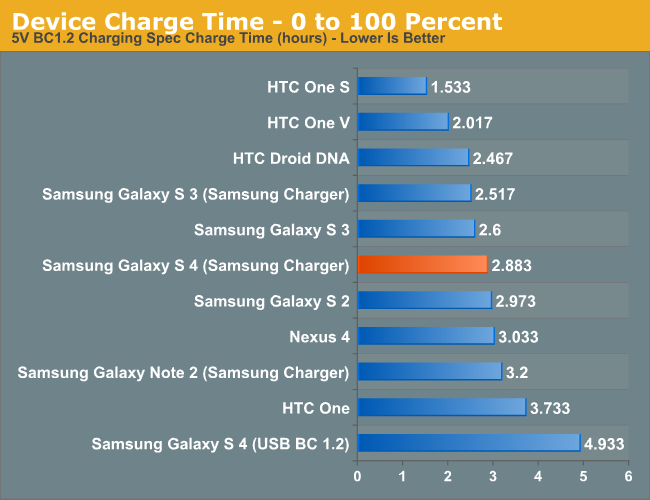


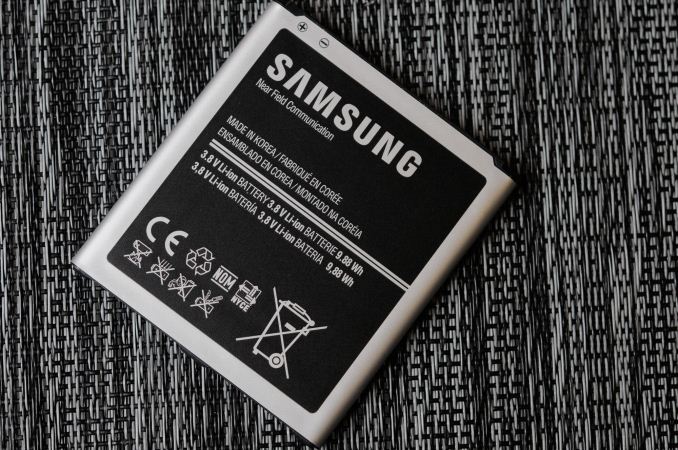








335 Comments
View All Comments
darwinosx - Wednesday, April 24, 2013 - link
Very few people have seen a Nexus phone or pure Android so its not correct to assume they prefer Touchwiz.nitenichiryu1 - Wednesday, April 24, 2013 - link
i agree! i actually prefer vanilla android to all the companies' versions of android.seamonkey79 - Wednesday, April 24, 2013 - link
Won't buy a phone without a removable battery. After two iPhone batteries and my friend's One X battery crapped out, it simply isn't worth it. Wouldn't mind a little bit better build from Samsung, but honestly my Note 2 is as good as my HTC Incredible was.Grandpa - Wednesday, April 24, 2013 - link
Wow. That's saying a lot. My old HTC Incredible had the most incredibly bad battery EVER. So bad I bought an iPhone with a terrific battery and lovin every minute of it.lilmoe - Wednesday, April 24, 2013 - link
let me guess, part 2 is for the Exynos GT-I9500 version.....berantle - Wednesday, April 24, 2013 - link
Thanks for the review. I'll be going with the HTC One. It is a better fit for me and my phone usage. I really like the HTC One's front stereo speakers. The S4 has too many new features/functions that I have little interest in using.The removable battery of the S4 is not important to me because even having had phones with a removable battery, I never felt a need to swap it out. Much better to recharge using a recharging battery pack - it's universal for charging other portable devices, plus the current packs can store 3-4x the energy that the batteries fitted in the phones can store.
Don't need removable SD card feature. Backed up my contacts/data to the cloud and to the PC. Do that regularly. I don't use my phone as a dumping ground for my music and movie files. Those go into my phone selectively and actively managed as to what I want in my phone storage.
The camera in the phones. I don't use them to replace my normal cameras. It's for the occasional shot and these skew to more indoors than outdoors. Thus, the HTC One's camera makes a better fit for me than the S4 camera. In my brief use of an HTC One, I tried the HTC One in a close macro shot and liked the results very much.
Aluminium or Polycarbonate? I have no problems with polycarbonate if it is nicely done like the recent Nokia phones and the HTC One X/Butterfly phones. The feel of the S3 was offputting and since the S4 is more of the same, then, no thanks. Holding the aluminium-cased HTC One, the big difference in feel makes me abhor the S3's feel even more, what more the S4 which is supposed to be the same.
rohini - Wednesday, April 24, 2013 - link
The SGS4 is surely a great smartphone but there are many other things which the buyers want from their smartphone. The aesthetics is the most important feature on the wish list of smartphone buyers. Samsung, you should know that people are now bored of your old plastic design. Why can't you come up with something made out of metal or glass or even sapphire?All Samsung has been doing for years is stuffing up its phones with the best in class hardware but forgot about what most of the persons like.
HTC One on the other hand is a an excellent example of innovation even though there are chances that it will fail to attract masses in the Indian market. http://goo.gl/VBNDG
nitenichiryu1 - Thursday, April 25, 2013 - link
Some have posted comments on how the S4 will have a locked bootloader (bummer), and that the HTC will be unlocked, but what about the recent article from engadget stating that it will change for the HTC, and most likely be locked. http://www.engadget.com/2013/04/15/htc-one-att-boo...teiglin - Thursday, April 25, 2013 - link
Skimming through the comments makes my head hurt. I wonder what percentage of idiotic commenters are marketers and what percent are legit fanboys. I hope they're mostly marketers; it's a bit scary to think that Samsung and HTC might have developed reality distortion fields that rival Apple's.Anyway, on the off chance you're still reading any of this garbage, Brian, I wanted to ask why you never do any reviews of custom ROMs/kernels. I realize this is a potential deathtrap of complication, so is it just that it's easier just to avoid even opening the door to it? I mean, the number of boneheaded manufacturer moves that can be fixed by some minor aftermarket tweaking is phenomenal: everything from silly button bindings (One) to janky design language (Touchwiz) to miserable screen calibration (Nexus 4) can be solved by spending 10-30 minutes on xda--and that's without even going into the less-stable areas or just-for-fun tweaks.
AndroidsFinest - Thursday, April 25, 2013 - link
I think I will wait to see what Google has to offer at Google I/O, if its just a revamped Nexus 4 than I might go for the HTC One. Samsung's plastic is getting a bit tiresome and off contract the 8 core international variant is extremely overpriced.